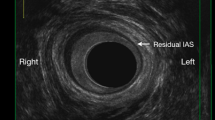Abstract.
Background:
Cutting setons have been used in complicated perirectal sepsis with good effect, although there is a moderately high incidence of fecal leakage after their use. The aim of this study was to compare a modified cutting seton, which repaired the internal anal sphincter muscle and re-routed the seton through the intersphincteric space, with a conventional cutting seton.
Methods:
A total of 34 patients were randomized between 1998 and 2002. They were prospectively assessed by continence score and anorectal manometry, and for anal function, clinical sepsis and fistula recurrence.
Results:
There was no difference in postoperative continence score, incidence of recurrent fistula or healing time between groups after a mean follow-up of 12 months. Resting anal manometric pressures and vector volumes were consistently higher with the modified seton (although not statistically significant), as was the area under the inhibitory curve during elicitation of the rectoanal inhibitory reflex across the full sphincter length. (p<0.05).
Conclusion:
A larger prospective study of internal anal sphincter-preserving seton use in cryptogenic high transshincteric fistula-in-ano appears justified.
Similar content being viewed by others
Author information
Authors and Affiliations
Corresponding author
Rights and permissions
About this article
Cite this article
Zbar, A.P., Ramesh, J., Beer-Gabel, M. et al. Conventional cutting vs. internal anal sphincter-preserving seton for high trans-sphincteric fistula: a prospective randomized manometric and clinical trial. Tech Coloproctol 7, 89–94 (2003). https://doi.org/10.1007/s10151-003-0016-6
Received:
Accepted:
Issue Date:
DOI: https://doi.org/10.1007/s10151-003-0016-6




